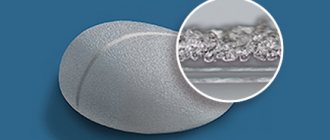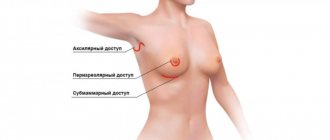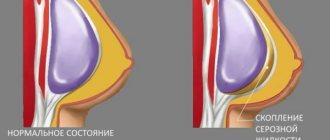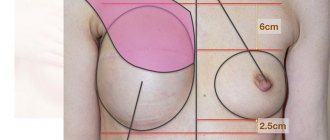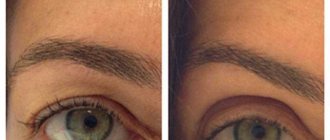Seroma is a rare complication after mammoplasty, occurring in only 1-2 percent of patients. Most often occurs after breast augmentation with large-volume implants and after a mastectomy. There are also risks for patients with diseases such as diabetes, obesity and high blood pressure. Older patients are also at risk. The culprits for the occurrence of this disease can be either a patient who does not correctly follow all the recommendations during the rehabilitation period, or a surgeon who made a mistake during the operation. This is a very unpleasant and dangerous complication. Seroma is a viscous liquid with a sweetish odor and a yellowish tint, which contains lymphocytes, leukocytes and other blood cells.
Seroma, what is it and how to treat it
The presence of seroma after breast surgery is most often observed when large implants are used and breast augmentation. Fluid accumulates under the skin and can cause it to stretch. Subsequently, the breasts become less firm and sag. Seroma after mammoplasty is considered a complication not so much dangerous as unpleasant. As a rule, it occurs in the early stages after surgery - 5-10 days after breast surgery.
Signs of seroma after mammoplasty:
- breast asymmetry, namely changes in the breast in the area of fluid accumulation;
- slight pain;
- redness of the skin;
- asymmetrical swelling;
- leaking serous fluid through wounds;
In cases of suspected accumulation of serous fluid, you must consult a doctor who will prescribe the necessary tests and treatment. Diagnosis of seroma after mammoplasty is performed by examination, ultrasound, MRI or mammography. The surgeon operating on you will advise which diagnostic method to choose.
Causes of seroma after mammoplasty:
- internal bleeding;
- failure to drain the operated area or poorly performed procedure;
- large hematomas can lead to fluid accumulation; observation is necessary if they are present;
- reaction to suture material;
- excessive tissue burn by coagulator;
- infection;
- injury to lymphatic vessels;
- early physical activity on the part of the patient;
- failure to follow all doctor’s recommendations after mammoplasty.
Why do complications occur?
More often complications appear for three reasons :
- Medical error
- Poor quality examination of the patient before surgery
- Disobedience of the man himself
It is important to consult a professional plastic surgeon . If the doctor has extensive experience in performing this type of operation, uses modern techniques and works with advanced equipment, then the risk is minimal.
Before the operation, you not only need to pass all the tests, but also undergo several consultations with the surgeon and some specialized doctors. It is good when the patient does not hide anything , but speaks openly about everything that can affect the outcome of the operation.
And, lastly, complete obedience to the surgeon’s recommendations , not only before augmentation mammoplasty, but also after it. For example, if physical activity is prohibited, you should not try to test your body’s strength. The same applies to smoking, drinking alcohol, eating right, and so on.
Treatment of seroma after mammoplasty
In most cases, seroma resolves on its own within a few days, less often it accumulates, causing physical discomfort to the patient and leading to more serious complications. That is why regular examinations after mammoplasty are very important; this will promptly prevent the risk of complications, and in cases of complications, quickly eliminate them.
Treatment of seroma after mammoplasty includes:
- medicinal method - treatment with antibiotics and anti-inflammatory drugs, helps in cases of small amounts of accumulation of serous fluid;
- surgical method - installation of drainage through small punctures, as a rule, drainage is installed for several days to drain excess fluid and blood;
- combination of drug and surgical treatment;
- vacuum aspiration – a special device uses a vacuum to pump out fluids from tissues through newly dissected postoperative scars.
Lack of treatment can lead to serious problems - suppuration, necrosis and capsular contracture. In this case, treatment will consist of removing the implants. Remember, timely examinations, strict adherence to the rehabilitation period, and most importantly, a competent choice of surgeon - guarantee a successful outcome of the operation and minimize the risk of seroma after mammoplasty.
© PlasticRussia, 2021. All rights reserved. Full or partial copying of site materials without the consent of the portal administration is prohibited.
2
Seroma after mammoplasty: causes and methods of elimination
The first signs of seroma after mammoplasty appear 4–14 days after breast augmentation procedures. The woman pays attention to the asymmetry: one gland enlarges and swells, which is accompanied by pain and redness of the skin. Do not confuse gray after mammoplasty with normal swelling, which goes away on its own.
Complications and mammoplasty: seroma
Seroma is a liquid, the consistency and color of which depends on its composition. Slightly yellow, slightly viscous, it contains lymphocytes, leukocytes, macrophages and other blood cells. The red tint of the seroma is given by red blood cells, and the viscosity is given by lipids and proteins.
Seroma emits a slightly sweet, distinct odor when it flows through a surgical wound or fistula.
Seroma after mammoplasty: clinical picture
Symptoms of seroma after mammoplasty tend to appear not immediately, but after several weeks or even months.
- Changing the shape of the breast. The increase in volume is explained by the accumulation of fluid in the tissues, which leads to distortion of the contour in a certain place (formation of a lump) and even displacement of the nipple.
- Swelling. Since the accumulated seroma is not limited to the capsule, it tends to penetrate into all soft tissues. On palpation, elasticity of the entire organ and skin tension are noted.
- Redness of the skin is explained by the internal pressure of accumulated fluid, as well as partial destruction of blood vessels. Often accompanied by a hematoma.
- Pain during palpation, walking, or physical activity indicates the accumulation of a large volume of seroma and its prolonged existence.
Untimely contact with a surgeon can provoke the formation of a fistula. A fistula is a channel through which exudate flows out. Women with soft and extremely thin skin are prone to the formation of fistulas. Those at risk are those who have enlarged their breasts several sizes, thereby causing skin tension.
Seroma after mammoplasty: causes
Seroma after mammoplasty is a rare occurrence. In most cases, it resolves within a few days, less often it accumulates, causing physical and moral discomfort to the patient.
- One of the causes of seroma is damage to the lymphatic vessels and the flow of lymph into the tissue. The diameter of some of them is so small that they are not subjected to adhesions, since they thrombose on their own. If thrombosis does not occur, the ichor accumulates.
- Seroma after mammoplasty is often considered a consequence of hematoma. The blood accumulated in the implantation pocket is resolved, but the exudate remains.
- Reaction to materials. Implants and suture material are foreign bodies, the body’s reaction to which is difficult to predict. At risk are people with hypersensitivity and allergies. Despite the use of innovative materials that are biologically inert, they can still cause swelling and accumulation of ichor.
The list of reasons that provoked seroma after unsuccessful mammoplasty includes the unprofessionalism of the plastic surgeon and medical errors.
- The operation involves dissection of all layers of the chest, and therefore is a highly traumatic procedure. A doctor with inadequate qualifications is not able to perform the manipulation with high quality and precision.
- Poor drainage of the implantation pocket (with active aspiration) or its complete absence.
- Infection during surgery.
The patient herself can provoke seroma after a successful mammoplasty, without following the regimen and other doctor’s recommendations:
- incorrect wearing of compression garments,
- improper care
- early physical activity.
Dangers Caused by Seroma After Mammoplasty
Ignoring the symptoms described above contributes to the deterioration of the condition. Quite often, women experience capsular contracture, suppuration followed by necrosis. In such cases, the question of repeated surgery is raised to remove the implant and excise dead areas.
Treatment of seroma after mammoplasty
Treatment of seroma consists of ensuring the outflow of ichor, relieving pain and inflammation, and preventing relapse. In case of extensive seroma, it is advisable to install drainage. If it is small, drug treatment is practiced: broad-spectrum antibiotics, gels and ointments.
What are the complications?
Here are the most common ones:
Seroma is a collection of serous fluid that is usually located between the implant and the glandular tissues of the breast. The first reason is that the pocket for the implant is too large, the second reason is when there is no postoperative drainage, when the patient allows serious physical activity ahead of time, when the woman does not wear compression garments, etc.
A hematoma is an accumulation of blood clots between the breast tissue and the implant. It appears when the surgeon damages important blood vessels during the operation and ends the operation before making sure that there is no bleeding. A hematoma can also occur if during the rehabilitation period the pressure rises sharply or the blood clots poorly. It happens that the size of the endoprosthesis does not correspond to the size of the pocket in which it is placed.
Capsular contracture is when the shape of the breast is distorted due to a dense layer of scar tissue formed around the endoprosthesis.
Most often, this type of complication occurs when the implant is located supramuscularly. The defect is eliminated surgically.
Getting infected. If an infection gets inside, suppuration occurs around the implant. This can be eliminated with the help of antibiotics or removal and complete replacement of the endoprosthesis. The cause may be internal bleeding, failure to comply with aseptic standards, etc.
Implant displacement. The direction and reasons for the displacement may be different. For example, if there was a mechanical impact on the breast, the implant can move in any direction. If displacement occurs under the force of gravity, then the implant, as a rule, goes down, etc.
If the prosthesis is large and located above the pectoral muscle, then the probability of its displacement is much higher. Silicone implants used in our clinic are displaced much less frequently, since they are much lighter than saline implants. The location of the endoprostheses also matters.
If the implant displacement is quite large, repeated surgery is required.
What is possible?
- Sport.
After six months of recovery, you can gradually begin to introduce exercises that involve the pectoral muscles. The main thing is to discuss this with your surgeon and remember to wear a bandage top. You can also return to running. - Linen.
No more restrictions in choosing underwear! You can wear any bra you want, whether it's wired or not. However, try to give preference to the models in which you are most comfortable. Excessive pressure is harmful to any breast. - A tan.
If the rehabilitation progresses well, the sutures should heal sufficiently within 6 months to withstand exposure to ultraviolet rays without problems. Therefore, if before this you limited yourself in sunbathing, now you can safely go to the beach or solarium. - Bathhouse.
In some cases, little by little steaming is allowed after the 3rd month, but we recommend waiting six months to minimize the risk of unpleasant consequences.

